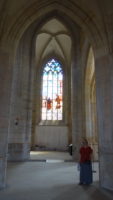 Meredith assures me she would always rather travel with me than without me. I may have tested that love today as we headed off to Kunta Hora, with my twenty-seven variations of “Kunta Hora” set to the tune of “Hakuna Metata,” from Lion King. I’m sure Mer was endlessly thrilled.
Meredith assures me she would always rather travel with me than without me. I may have tested that love today as we headed off to Kunta Hora, with my twenty-seven variations of “Kunta Hora” set to the tune of “Hakuna Metata,” from Lion King. I’m sure Mer was endlessly thrilled.
The drive from Jicin to here was only about an hour, and so we got here around 11:00. Since we knew it was going to be too early to check in to the hotel, we drove to the Sedlec Ossuary. An ossuary is a place for depositing bones, which is not all that unusual in space-constrained European towns, but what is unusual is when the people in charge start decorating with bones.
While we were there to see the ossuary, we wandered the outside graveyard first. Many of the headstones were from the twentieth century, and many had photos attached to the marker. Most plots were in family groups.
We went into the small chapel above the ossuary despite Mer’s guidebook saying it was dull; Meredith is rather OCD about seeing everything at a sight if it is free or included. We are both glad we did. The church is plain and small, but what was really striking is that the wall had twelve modern paintings of the life of Christ, starting with the triumphal entry and ending with some scenes after the resurrection of Jesus (who, being mistaken as the gardener by the woman at the tomb, is shown rather charmingly carrying a shovel). I loved the art, and even bought a copy of the paintings in a book that cost something like $1.50.
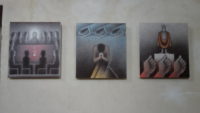 A monk piled up bones into pyramids in the crypt of the church in the 1600s, and then later, in the 1800s, an architect decided to expand that vision into full decorations made out of human bones. It is a bit odd, yes, but the point of these things (and this is the third such place to which we have been in Europe) is that life is short, and then you have to face God. The recording to which we were listening even gave a non-pushy version of the gospel, telling us that these dead were waiting in hope for the resurrection of the dead in Jesus.
A monk piled up bones into pyramids in the crypt of the church in the 1600s, and then later, in the 1800s, an architect decided to expand that vision into full decorations made out of human bones. It is a bit odd, yes, but the point of these things (and this is the third such place to which we have been in Europe) is that life is short, and then you have to face God. The recording to which we were listening even gave a non-pushy version of the gospel, telling us that these dead were waiting in hope for the resurrection of the dead in Jesus.
As for the actual decorations, there were two huge chalices, a cross, a coat of arms, three of the four original pyramids (one was in storage during a renovation project), and some other small patterns, including the name of the designer, in bone. But by far the biggest and most ornate one was a huge chandelier in the middle of the chamber, which, our audio guide informed us, contained at least one of every major bone in the human body. Sorry, folks, no pictures – for me, I personally feel as if it is disrespectful to take photos of the dead; I’m not sure why. Seeing the display is okay for me since it fulfills the purpose of reminding me about the importance of the hope of eternal life.
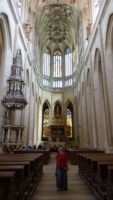 We drove over to the hotel, even though it was too early to check in still, if only to park the car. We haltingly made our way into the center of town about three-quarters of a mile away, following road signs as best we could. We managed. Mer took me to near the top of the hill of the town, where we came around a corner and saw St. Barbara’s Cathedral, which is sort of huge and completely magnificent. I say “sort of huge” because it is oddly tall for the length of the church: the original plan had been to make the church longer, but the money ran out as the town’s silver mines dried up over four hundred years. The church was started around 1400 and was finally finished, after several long stoppages of construction, in the early 1900s.
We drove over to the hotel, even though it was too early to check in still, if only to park the car. We haltingly made our way into the center of town about three-quarters of a mile away, following road signs as best we could. We managed. Mer took me to near the top of the hill of the town, where we came around a corner and saw St. Barbara’s Cathedral, which is sort of huge and completely magnificent. I say “sort of huge” because it is oddly tall for the length of the church: the original plan had been to make the church longer, but the money ran out as the town’s silver mines dried up over four hundred years. The church was started around 1400 and was finally finished, after several long stoppages of construction, in the early 1900s.
The exterior of the church is striking because of the height, and for the long flying buttresses along the walls. In between the buttresses are huge windows – stained glass from the early 1900s (except for one Chagall-esque window from 2013) on the lower level and clear glass on the upper level. The clear glass allows the church to be flooded with light and makes for a very clean-looking interior, especially after some of the fanciful Baroque churches we have seen on the trip.
Since silver paid for the church, there are many tributes to miners. In fact, the church was supposed to have been founded by some miners who got trapped underground, and who then prayed to St. Barbara, the patron saint of miners. They were supposed to have been shown where to dig to get out of the mine. One of them had a vision of Barbara at a tree in the forest, so he carved a statue of her out of the tree, which attracted worshipers, and so that became where the cathedral was built. In an unusual move for a church, there is a full-sized statue of a miner in a place where there would usually be a saint.
Silver was mined here for about four hundred years, from about 1300 to about 1700, making Kutna Hora a very rich town. The coin minting operation in the town supplied coins all over Europe. Some of the people who did not benefit much seemed to be the miners. We went to the town silver museum and took a tour of a mine shaft. Being a miner, to put it bluntly, sucked. Once the mine got deep, you had to take up to three hours to get into the mine, work a six-hour shift (or more, in later years), and then spend three to four hours climbing back out of the mine – thirteen or more hours a day, six days a week. Miners started work around twenty-one years old and generally retired (or were dead) by the age of forty, when they could help the women and children on the surface with the washing of the silver ore.
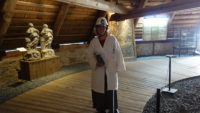
In the actual mine, the miners had small clay lamps by which to work. This was demonstrated for us in the mine, using a flickering flashlight. It was dim. In this dimness, the miner had to find any silver veins in the rock, where they would appear brown or grey or black. So he had to use hand tools to get a black rock out of a harder rock in the dark, lit only by a clay lamp. Miners also worked far apart to minimize casualties in case of a flood or a cave-in. It sounded like a very hard life.
The mine through which we walked was not like other mines we have visited; the miners were following veins of silver, and so the mine was very narrow, in many places only shoulder-wide. To get out of the mine, we had to walk along a shaft used for diverting water out of the mine, and in one spot, the roof was only four-and-a-half feet off the floor, and in another spot, it was only sixteen inches wide. I found out that I start to get antsy if I can’t stand up for long periods of time – I would have made a very bad miner, for many reasons.
The fun did not end with the miners, though. The mining pollution contaminated the area water. The people who purified the silver ended up breathing vaporized lead. And the minter, who hammered silver by hand, eventually went deaf from the noise. I’m grateful to live in the twenty-first century.
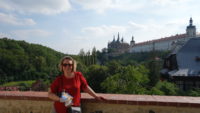
After supper outside facing a square, we ended the day by finishing up a walk of the town, enjoying the squares, the colorful buildings, and the magnificent views of St. Barbara’s Cathedral. Being in Kutna Hora means no worries.